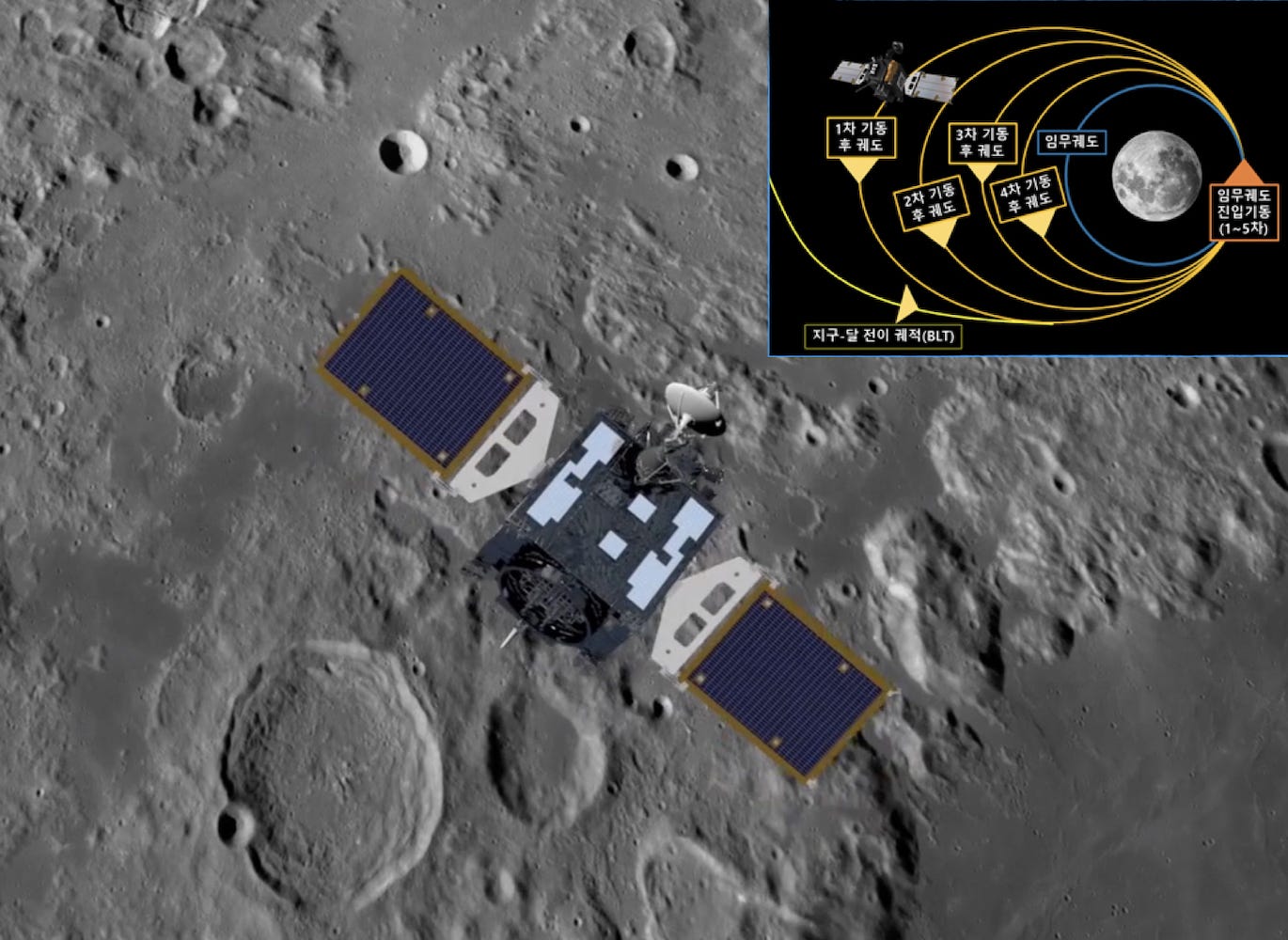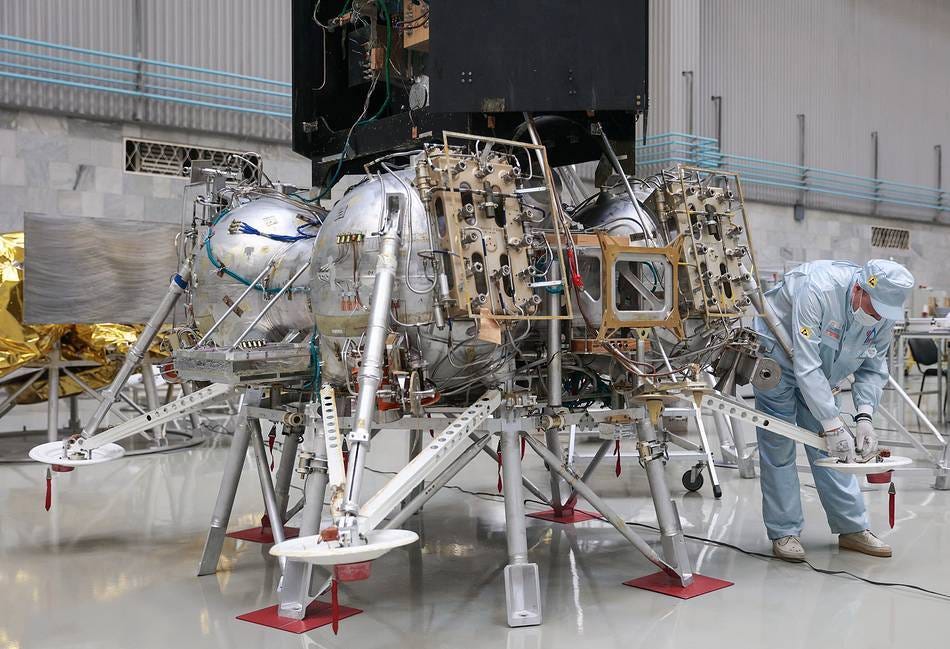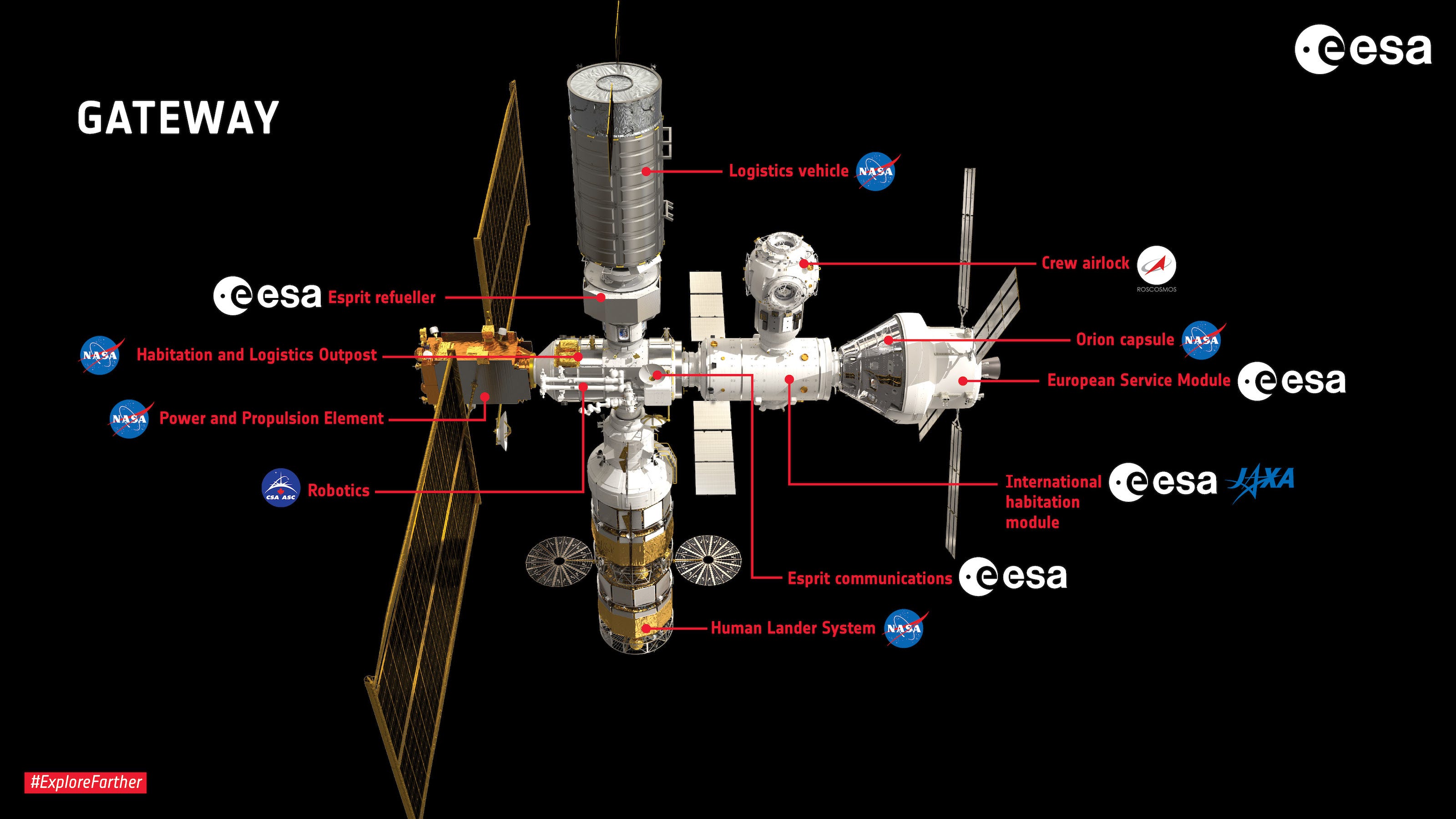Moon Monday #108: A lunarbound KPLO, many mission updates, future foundations, and more
I’ll be taking my year end break from publishing Moon Monday for two weeks, and get the much needed free time to rest, refresh, and reflect. The next edition will be out on January 9, 2023 and cover all updates between now and then. I hope you enjoy the end of the year doing whatever you love.
Relatedly, a major reason my space blog is called “Jatan’s Space” and not some media brand name is to highlight that I’m an independent writer publishing in individual capacity. Even though my newsletter and articles go out regularly—I’ve never missed a single Monday for Moon Monday—I hope the name reflects I’m not a machine.
KPLO now Moonbound!
On December 17, the Korea Pathfinder Lunar Orbiter (KPLO) successfully entered lunar orbit, making it South Korea’s first such spacecraft. By December 31, KPLO will circularize its lunar orbit to a roughly 100 kilometers altitude with various timely and precise engine burns. Equipped with four indigenously built instruments and the NASA-provided ultra-sensitive ShadowCam, KPLO will show us new views of the Moon’s surface starting from January 2023, which will help us plan future missions, including landing humans on the Moon’s south pole. The $182 million mission comprises the first phase of South Korea’s lunar exploration program. In the second phase, the country plans to launch a fully indigenous Moon lander in 2032.

We now have 8 orbiters at the Moon!
- NASA’s venerable Lunar Reconnaissance Orbiter
- NASA’s THEMIS-ARTEMIS pair of spacecraft, orbiting the Earth-Moon Lagrangian points
- China’s Queqiao relay satellite for Chang’e 4, halo orbiting Earth-Moon Lagrangian point #2
- ISRO’s Chandrayaan 2 orbiter
- China’s Chang’e 5 service module, in a Distant Retrograde Orbit
- The Advanced Space-led and NASA-funded CAPSTONE CubeSat, in a Near-Rectilinear Halo Orbit
- KPLO :D
Statuses of secondary Artemis I payloads
We have some more updates on the independent science & technology missions that launched alongside the Orion spacecraft on NASA’s Artemis I Moon mission.
- The biological experiment onboard BioSentinel was turned on by the mission team on December 5 while the CubeSat was more than 1 million kilometers away from Earth. Over the next six months, the experiment will measure the impact of deep space radiation on yeast from a solar orbit. The researchers chose yeast because their cells and human cells have many similar DNA damage and repair mechanisms. Terrestrial facilities can’t fully simulate the unique radiation environment of deep space so this study will provide us new insights on its effects on biological life as NASA seeks to establish long-term human presence on the Moon. NASA selected a similar lunar surface mission for launch in 2026 as part of its CLPS program.
- A few weeks ago, the LunaH-Map CubeSat successfully demonstrated autonomous optical navigation, an important ability for small satellites. Now the team is preparing to heat up the propulsion system to free a stuck valve. If that works, the mission can still be carried out late next year. Considering that the CubeSat is supposed to map hydrogen—an indicator of water ice—in permanently shadowed regions on the Moon’s south pole as well as a meter below the surface in high resolution, I really hope the long shot works.
- The Team Miles CubeSat established contact after all, with more information on future plans to follow soon. It’s a citizen science project aiming to autonomously travel at least 96 million kilometers in deep space using plasma propulsion, as a precursor to larger and more efficient spacecraft in the future.
- Contact was lost with the CuSP CubeSat just an hour after deployment on Artemis I launch day, November 16, due to an unexplained spike in battery temperature. The mission was supposed to study the solar wind from a solar orbit closer in than Earth’s so as to eventually vouch for a network of small solar weather monitoring stations spread across the inner Solar System that would give us a better three-dimensional understanding of our Sun’s activity and its threats to future human exploration of deep space.
More mission updates
- The Artemis I Orion capsule is now being returned to NASA’s Kennedy Space Center to know exactly how well its heat shield worked during its fiery reentry into Earth’s atmosphere. Before departing for the Kennedy Space Center, teams unloaded the Biology Experiment-1 payload, part of the many radiation experiments onboard, for scientists to study the effects of deep space radiation exposure on the experiment’s plant seeds, fungi, yeast, and algae during the 26-day mission.
- ispace Japan’s first lunar lander, launched on December 11, successfully completed the first orbital maneuver using its propulsion system on December 15 to stay on its fuel-efficient, four-month trajectory to the Moon. ispace also completed payload checks last week, and they all seem to be healthy. Here’s a picture of Earth taken by the Canadensys camera onboard.
- The launch of Russia’s Luna 25 robotic Moon lander was delayed from earlier this year to 2023 because its Doppler distance and velocity sensors underperformed during testing. TASS reports that working, qualified units of the same have now been installed on the lander. Luna 25’s instruments include an arm to sample material from 20 to 30 centimeters below the surface and then feed it to a laser spectrometer to determine elements and isotopes within. There’s also a neutron and a gamma ray spectrometer to identify the composition of the subsurface. The mission’s landing site, while not truly polar due to engineering constraints, is selected at about 70° South such that underground water ice can still be detected.
- NASA has completed testing a mass spectrometer that will soon be installed onboard Intuitive Machines’ second lunar lander, which will launch in 2023 as part of NASA’s CLPS program to the Moon’s south pole. NASA’s PRIME-1 drill on the lander will dig up soil up to a meter below the surface and the mass spectrometer will analyze it for water ice and other such volatiles.

Many thanks to Epsilon3 for sponsoring this week’s Moon Monday.
Future foundations
- To prepare for future Artemis lunar surface missions starting with Artemis III, NASA recently completed a multi-week test campaign with crews in pressurized suits doing Moonwalks and sampling operations in the lunar-like landscapes of Arizona. Another such campaign involved crew—including 3 JAXA astronauts—operating a prototype pressurized rover in a lunar-like terrain to inform the development of such a vehicle Japan intends to contribute as an asset for Artemis missions next decade. Relatedly, with the Lunar LTE Studies project, NASA is testing 4G and 5G connections in lunar-like terrestrial environments to inform designs for having said technology on the Moon.
- Sarwat Nasir reports that the UAE, in partnership with Boeing, is in talks with NASA to provide an airlock for the NASA-led international Gateway lunar orbital station. Russia was originally supposed to provide the airlock, per a joint statement in 2017, but the country later pulled out. An airlock would allow future Artemis astronauts on Gateway to do spacewalks—while around the Moon! With such a contribution, the UAE hopes to get the same deal from NASA as ESA, CSA and JAXA have—seats for their astronauts on the Gateway to prestige.
- Last week Nigeria and Rwanda became the first African countries to sign the NASA-led Artemis Accords for cooperative lunar exploration, bringing the total number of signee nations to 23. Marcia Smith reports how the U.S. is pushing for a broad, veto-less international participation in the Accords that’s independent of a country’s intentions to collaborate with NASA on Artemis missions. Relatedly, considering that South Africa is aiding NASA with an Artemis ground station deal, it might be interested in signing the Accords.
- Quantum Space, intending to develop serviceable spacecraft platforms in cislunar space, has raised $15 million. The company’s first commercial lunar satellite, QS-1, will launch in October 2024 on a 3-year mission to scan and track hardware in cislunar space using a high-resolution optical imager. Such a capability would’ve certainly been helpful to track the rocket body that smashed on the Moon’s farside earlier this year. Rachael Zisk reports that the company intends to build a network of such satellites. The spacecraft are to be made by Blue Canyon, the same company providing two communications satellites for Draper’s farside Moon landing mission part of NASA’s CLPS program.
- The first hot fire test of the redesigned RS-25 engine to be used on future flights of NASA’s SLS rocket, starting with the Artemis V mission, took place on December 14. The engine was shut down early at 209.5 seconds instead of the desired 500-second run. NASA and SLS’ lead engine contractor Aerojet Rocketdyne are analyzing the data to determine the reason for the early cutoff.
- In Phase 2 of the $3 million Break the Ice Lunar Challenge, NASA has selected 15 teams to design and build prototypes capable of efficiently extracting and transporting icy regolith on the Moon.

Every writer has a flagship article, the iPhone to their Apple. Here is mine, updated throughout for 2023 with all the latest developments:
If you’ve found value in this year’s archive of my 50 Moon Monday editions and 25+ articles on space exploration at large, please consider donating to support my work. As an independent writer, it really would mean the Moon to me. If you or your organization would like to sponsor Moon Monday instead, get in touch!
→ Browse the Blog | About
